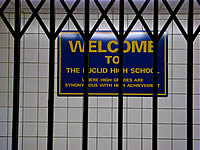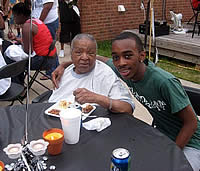
by Jordan Denari
EUCLID, OH—Several years ago, a school gymnasium in Cleveland collapsed, injuring teachers and frightening students. The incident got Jim Harmon, a high school teacher in Euclid, OH, wondering, “What message does that [incident] really send to students about the purpose of school?”
Harmon has taught high school English in a low-income area of nearby Euclid, where high school drop out rates are common. Many students “come to school just to survive” or to escape the hardships of home or neighborhood life.
He wanted to know his students’ thoughts about the purpose of school, and what they thought was helping or hindering their success. After identifying these factors, students would be able to consciously create a support system for themselves and avoid the things that impede their success at school.
Harmon, and colleague and friend Prof. Kristien Zenkov, wanted their students to be able to reflect on these questions and express themselves in a way that better served their learning styles.
“Kids today have...multiple literacies. It’s not just about textual literacies but it’s also about visual media literacies.”
Sharing a strong interest and talent in photography, Harmon and Zenkov developed a curriculum for middle schoolers and high schoolers called Through Students’ Eyes, which uses the ‘photovoice’ method. Participants receive cameras and an assignment: to document their life and, through photography, express their feelings and experiences in ways they could not through writing alone.
“The method...empowers them to share [their photographs], even if they’re not literate. It is a real powerful method of bringing social justice to traditionally underserved populations,” Harmon said of the method.
 The Through Students’ Eyes curriculum first asks students to photograph their answers to the questions: 1) What is the purpose of school? 2) What helps you succeed in school? 3) What gets in the way of your school success? Subsequently, students craft written explanations to accompany and explain their photographs. Emphasis is placed on interpreting others’ photographs, improving photography and writing skills, thinking critically, and sharing personal stories with peers and the community.
The Through Students’ Eyes curriculum first asks students to photograph their answers to the questions: 1) What is the purpose of school? 2) What helps you succeed in school? 3) What gets in the way of your school success? Subsequently, students craft written explanations to accompany and explain their photographs. Emphasis is placed on interpreting others’ photographs, improving photography and writing skills, thinking critically, and sharing personal stories with peers and the community.
Since it was created in 2004, Through Students’ Eyes has expanded to include students in the greater Cleveland area, northern Virginia, and even in Sierra Leon. The project has run eight times, sometimes in English or English as a Second Language classes during the school year, and sometimes in the summer.
Currently funded by generous local donors, the project is in the process of becoming a non-profit organization. For their voluntary participation in the program, students receive a stipend. This money is meant to offset the time spent in the project, during which many students could be working to support their families.
Student responses
According to Harmon, students begin to develop a thoughtful view of the purpose of school. When students initially said that they go to school because their moms make them, they exit the project saying they go to school to set an example, to support their family, or to gain access to basic material necessities, which many of them lack.
For the high school students in Euclid who recently completed the project, the question about impediments to success was the easiest question to answer. Students cited the death of a sibling, addiction, and concerns about what clothing to wear as factors that detracted from their learning.
To explain her struggle with obsessive compulsive disorder, student Breanna took a photograph of combination locks.
“These locks can represent security, paranoia, the never-ending locking and checking rituals,” she describes in her written piece. (Click here to see Breanna’s piece.)
The question about what contributes to school success was initially more difficult for the students to answer. But, after much thought, they came up with meaningful responses.
Many kids are motivated to work hard by parents’, aunts’ and uncles’, or grandparents’ expectations, or by the desire to set a positive example for a younger sibling. For others, being involved in school activities makes them feel like a part of the school community.
For Amber, writing is a stress-reliever that “helps me get out my emotions and frustrations.” Writing in her free time also helps her succeed because it improves her writing skills for the classroom.
Thinking bigger
In addition to better understanding their own views of school, the Euclid students took away many other lessons from the project.
When asked how the project affected her, Sherry, said, “I can think bigger thoughts [now]...It also made me think about how others feel. I think before I speak now and make sure I don’t hurt someone with words because words are a powerful tool to have.”
 The project also gave her a new perspective on the future. “It made me want to achieve [my goals] but if something goes wrong with my plans now I know not to worry myself out.”
The project also gave her a new perspective on the future. “It made me want to achieve [my goals] but if something goes wrong with my plans now I know not to worry myself out.”
For Amber, seeing and reading the stories of student participants in Sierra Leon affected her worldview.
“It helped me see how other people in the world are living, like the kids in Sierra Leon...I just think [if you lived in Africa] you’d be sad all the time because of the civil wars...going on, but [I see] how happy they are to have a computer. I just gave me insight in to how other people in the world are living and I like that.”
Adult-Student Relationships
It is not only teachers that work with Through Student’s Eyes, but also activists, artists, and journalists.
For some students, their relationships with their educators have turned into mentoring relationships. Hoping to become a journalist, Amber was able to shadow a journalist who worked with TSE. She was also able to attend an urban journalism workshop with the help of her TSE educator.
The fact that Amber has a connection with someone in her desired career field motivates her to reach her goal of becoming a journalist.
“I don’t think it takes much to get a kid interested,” Harmon said, “as long as [an adult] is willing to show a little interest in them.”




